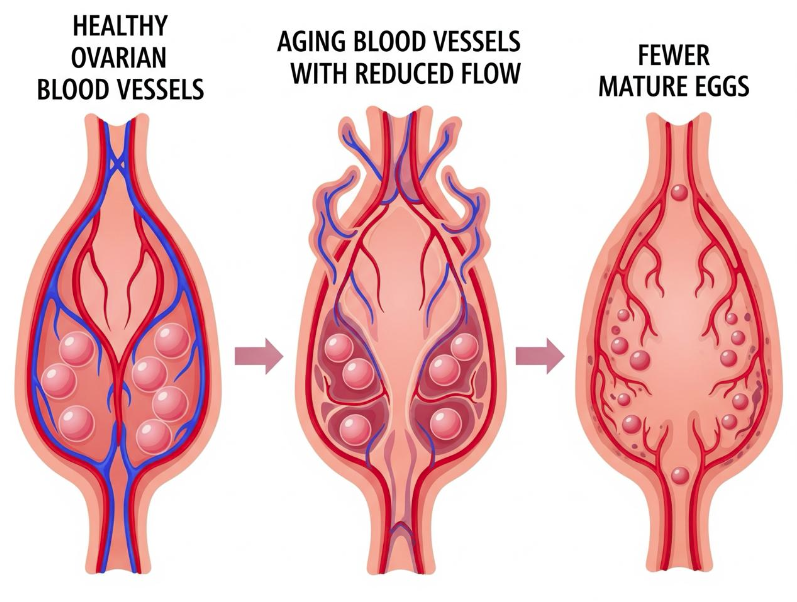
New Research Reveals Ovarian Aging Begins in Blood Vessels, Not Eggs

A groundbreaking new study in Science earlier this year from UCSF introduced a transformative way of understanding the ovary — not just as a set of eggs, but as a living ecosystem supported by nerves, blood vessels, and surrounding cells, all of which must work together for fertility to flourish.
Now, researchers have taken that concept even deeper. In a new study, “Physiological premature aging of ovarian blood vessels leads to decline in fertility in middle-aged mice,” scientists show that the earliest signs of ovarian aging begin in its blood vessels — not in its eggs.
These studies together suggest that the ovary’s vitality depends not only on egg number, but on the health of the microscopic environment that sustains them — what our NIH team long described as the “follicular ecosystem.”
What the New Research Shows
In this new report, scientists found that ovarian blood vessels age faster than those in other tissues. Before egg numbers decline, these tiny vessels begin to lose flexibility and function — a process that reduces blood flow, oxygen delivery, and waste removal inside the ovary.
This vascular “aging” weakens the ovarian environment, causing fewer follicles to mature properly even when eggs are still present. Remarkably, when researchers stimulated new vessel growth, ovarian function improved — suggesting that restoring healthy circulation could help sustain fertility and hormone balance.
Why This Matters for Women with POI
For women with Primary Ovarian Insufficiency (POI), this new science offers both explanation and encouragement. Many women with POI still have follicles, but their ovarian environment may not be getting the signals or support it needs — similar to what these animal studies show.
This underscores a truth we’ve learned from decades of work at the NIH Intramural Research Program:
POI is not just about egg loss — it’s about system disruption. The ovary is an ecosystem, and every part — blood flow, hormones, and local signaling — matters.
Supporting the Ovarian Ecosystem: Whole-Person Readiness
While scientists continue to explore therapies to restore ovarian circulation, women can already take essential steps to support vascular health throughout the body — and by extension, the ovary:
- Stay active: Gentle, regular movement enhances nitric oxide (NO) production, which keeps blood vessels open and flexible.
- Eat a heart-healthy diet: Focus on colorful fruits, vegetables, olive oil, and omega-3 fats to nourish microvascular function.
- Avoid smoking: Tobacco directly damages the endothelium (vessel lining).
- Manage blood pressure and cholesterol: Systemic circulation supports every tissue, including reproductive organs.
- Consider physiologic hormone replacement: Estradiol (E2) promotes vessel dilation and supports healthy nitric oxide balance — improving circulation in the heart, brain, and ovaries.
- Nurture your emotional and spiritual health: Chronic stress constricts blood vessels; calm and compassion may help them reopen.
The Bigger Picture
Science continues to affirm what women with POI have always known: the ovary — like the woman herself — is resilient, responsive, and deeply interconnected with the rest of the body.
At the Conover Foundation and through the Primary Ovarian Insufficiency Readiness™ Initiative, we believe readiness begins with understanding — of self, science, and hope. Each discovery brings us one step closer to helping the ovarian ecosystem thrive again.
For the full research study in Science on the ovarian ecosystem in mice, see:
For the full research study in Nature Communications on ovarian blood flow in mice, see:




